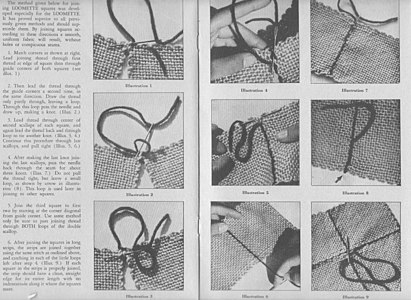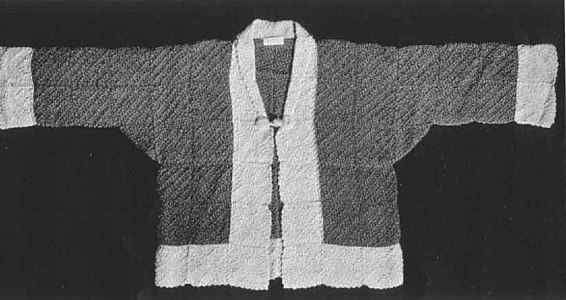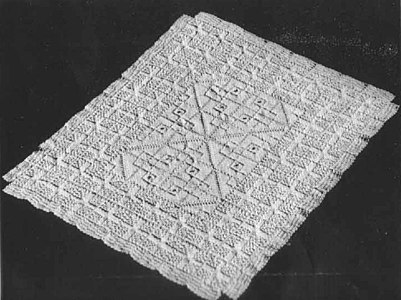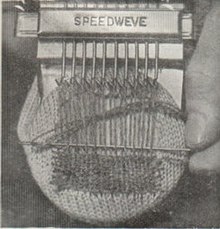Bead weaving is a set of techniques for weaving sheets and objects of seed beads. Threads are strung through and/or around the beads to hold them together. It can be done either on a loom or using one of a number of off-loom stitches.

Knitting is a method for production of textile fabrics by interlacing yarn loops with loops of the same or other yarns. It is used to create many types of garments. Knitting may be done by hand or by machine.

A loom is a device used to weave cloth and tapestry. The basic purpose of any loom is to hold the warp threads under tension to facilitate the interweaving of the weft threads. The precise shape of the loom and its mechanics may vary, but the basic function is the same.

Denim is a sturdy cotton warp-faced textile in which the weft passes under two or more warp threads. This twill weave produces a diagonal ribbing that distinguishes it from cotton duck. Denim, as it is recognized today, was first produced in Nîmes, France.
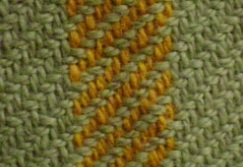
Twill is a type of textile weave with a pattern of diagonal parallel ribs. It is one of three fundamental types of weave, along with plain weave and satin. It is made by passing the weft thread over one or more warp threads then under two or more warp threads and so on, with a "step," or offset, between rows to create the characteristic diagonal pattern. Because of this structure, twill generally drapes well.
Ikat is a dyeing technique from Indonesia used to pattern textiles that employs resist dyeing on the yarns prior to dyeing and weaving the fabric. The term is also used to refer to related and unrelated traditions in other cultures. In Southeast Asia, where it is the most widespread, ikat weaving traditions can be divided into two general clades. The first is found among Daic-speaking peoples. The second, larger group is found among the Austronesian peoples and spread via the Austronesian expansion. Similar dyeing and weaving techniques that developed independently are also present in other regions of the world, including India, Central Asia, Japan, Africa, and the Americas.

Damask is a reversible patterned fabric of silk, wool, linen, cotton, or synthetic fibers, with a pattern formed by weaving. Damasks are woven with one warp yarn and one weft yarn, usually with the pattern in warp-faced satin weave and the ground in weft-faced or sateen weave. Twill damasks include a twill-woven ground or pattern.

Double cloth or double weave is a kind of woven textile in which two or more sets of warps and one or more sets of weft or filling yarns are interconnected to form a two-layered cloth. The movement of threads between the layers allows complex patterns and surface textures to be created.

Darning is a sewing technique for repairing holes or worn areas in fabric or knitting using needle and thread alone. It is often done by hand, but using a sewing machine is also possible. Hand darning employs the darning stitch, a simple running stitch in which the thread is "woven" in rows along the grain of the fabric, with the stitcher reversing direction at the end of each row, and then filling in the framework thus created, as if weaving. Darning is a traditional method for repairing fabric damage or holes that do not run along a seam, and where patching is impractical or would create discomfort for the wearer, such as on the heel of a sock.

Paithani is a variety of sari, named after the Paithan town in Aurangabad district from state of Maharashtra in India where the sari was first made by hand. Present day Yeola town in Nashik, Maharashtra is the largest manufacturer of Paithani.

Pile weave is a form of textile created by weaving. This type of fabric is characterized by a pile—a looped or tufted surface that extends above the initial foundation, or 'ground' weave. The pile is formed by supplemental yarn running in the direction of the length of the fabric or the width of the fabric. Pile weaves include velvet and corduroy fabrics and machine-woven Berber carpets.

Plain weave is the most basic of three fundamental types of textile weaves. It is strong and hard-wearing, and is used for fashion and furnishing fabrics. Fabrics with a plain weave are generally strong, durable, and have a smooth surface. They are often used for a variety of applications, including clothing, home textiles, and industrial fabrics.

Knitted fabric is a textile that results from knitting, the process of inter-looping of yarns or inter-meshing of loops. Its properties are distinct from woven fabric in that it is more flexible and can be more readily constructed into smaller pieces, making it ideal for socks and hats.

A selvage or selvedge is a "self-finished" edge of a piece of fabric which keeps it from unraveling and fraying. The term "self-finished" means that the edge does not require additional finishing work, such as hem or bias tape, to prevent fraying.
Kersey is a kind of coarse woollen cloth that was an important component of the textile trade in Medieval England.
The manufacture of textiles is one of the oldest of human technologies. To make textiles, the first requirement is a source of fiber from which a yarn can be made, primarily by spinning. The yarn is processed by knitting or weaving, which turns yarn into cloth. The machine used for weaving is the loom. For decoration, the process of colouring yarn or the finished material is dyeing. For more information of the various steps, see textile manufacturing.
Textile manufacturing is one of the oldest human activities. The oldest known textiles date back to about 5000 B.C. In order to make textiles, the first requirement is a source of fibre from which a yarn can be made, primarily by spinning. The yarn is processed by knitting or weaving to create cloth. The machine used for weaving is the loom. Cloth is finished by what are described as wet process to become fabric. The fabric may be dyed, printed or decorated by embroidering with coloured yarns.

Waffle fabric, also known as honeycomb fabric, has raised threads that form small rectangles. It can be made by either weaving or knitting. Waffle weave is a further exploitation of plain weave and twill weave which produces a three-dimensional effect. The combination of warp and weft floats creates the structure. It is woven partly on tabby areas surrounded by ridges of long floats. The weave consists of warp and weft floats arranged around a plain weave center. The warp and weft threads are interlaced and floating in a way that creates small square ridges and hollows in the fabric in a regular pattern.
Sewing is the craft of fastening or attaching objects using stitches made with needle and thread. Sewing is one of the oldest of the textile arts, arising in the Paleolithic Era. Although usually associated with clothing and household linens, sewing is used in a variety of crafts and industries, including shoemaking, upholstery, sailmaking, bookbinding and the manufacturing of some kinds of sporting goods. Sewing is the fundamental process underlying a variety of textile arts and crafts, including embroidery, tapestry, quilting, appliqué and patchwork.

Leno weave is a weave in which two warp yarns are woven around the weft yarns to provide a strong yet sheer fabric. The standard warp yarn is paired with a skeleton or 'doup' yarn; these twisted warp yarns grip tightly to the weft which causes the durability of the fabric. Leno weave produces an open fabric with almost no yarn slippage or misplacement of threads.











